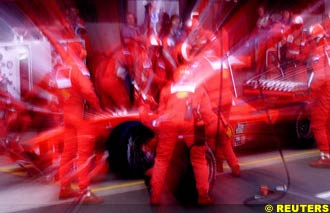Critics of Formula One racing have been saying lately that "it's about as exciting as watching a chess match." Well, if you know even a modest amount about chess, watching a match is extremely exciting. The whole board and the positions of the pieces of both players are set out before you. You have a sense of what they've been trying to achieve and you can, yourself, vicariously take part in the match by thinking about what you would do next if you were in their place. It's extremely involving.
 Yes, strategy is now king in Formula One. You have to work out the balance among tyre grip and wear, fuel consumption, driver capability, car weight and performance to put together the best pattern of fuel and tyre stops to achieve the best placing for your cars. It is a bit like a chess match in that you don't know what offense or defense your rivals are planning. It's not like a chess match in that the spectators don't know - until it happens - exactly what actions may be available to the teams to implement in order to achieve their objectives.
Yes, strategy is now king in Formula One. You have to work out the balance among tyre grip and wear, fuel consumption, driver capability, car weight and performance to put together the best pattern of fuel and tyre stops to achieve the best placing for your cars. It is a bit like a chess match in that you don't know what offense or defense your rivals are planning. It's not like a chess match in that the spectators don't know - until it happens - exactly what actions may be available to the teams to implement in order to achieve their objectives.
Before Silverstone Johnny Herbert was dismissive of the Ferrari strategic style. He said: "There's not a lot of flair in the way Ferrari go about racing with Ross Brawn. Ross's approach is very dot-to-dot. He has a plan for if something happens on the first lap, the second lap, all the way through the race. If this happens we do this, then we do that. That's not romantic. That's racing by computer. It works... but it's not about spontaneous flair."
Where did 'spontaneous flair' get Johnny's Jaguar team at Silverstone? Nowhere, that's where. And here's why. Racing teams have invested multi-millions in their cars, their drivers and their infrastructure of equipment and mechanics. What's the point of placing all this at the mercy of 'spontaneous flair'? Each team is obliged to use all the science and computing power that it can to provide its strategists with real-time information about their cars' performance and those of their rivals during a race. Use of computer programs to forecast moves and counter-moves? That's just like championship chess!
Of course the old computer acronym applies: GIGO, meaning Garbage In = Garbage Out. This is the trickiest part of any Formula One strategic exercise: getting the needed data from practice sessions that may not correspond at all to the conditions in which the race is run. With all the weather-interrupted sessions at Silverstone this was especially difficult. This is where the Ross Brawns of this world come in, taking Michael Schumacher from an eighth-place runner during the first half to a podium position in the British GP. And this time McLaren hit it right with a controversial (in relation to tyre wear) but winning one-stop strategy.
McLaren seems to come a cropper when conditions change, thus demanding flexibility. The chain of command from Steve Hallam to Ron Dennis seems to be less responsive than from Ross Brawn to Ross Brawn at Ferrari, Ross working with the data at his command without having to double-check with anyone. It didn't matter at Silverstone: McLaren had set its strategy and just had to stick with it. Its drivers were fully able to make the strategy work.
I haven't seen the computer software that's been developed to help the teams prepare, display and update their strategies during a race, but it must be awesome. It should be: it's about the only electronic support system that the FIA hasn't found a way to control or ban! Look for this capability to be developed even further in the future.
Who's losing out in all this? The spectator, that's who, not only at the track but also on the tube. It's about time that broadcasters stepped up to the strategic challenge by finding a way to display graphically the pattern of pit stops in relation to the length of the race. They could do a lot more to help the Formula One fan participate more fully in the evolution of a race - just like the chess fan can!

